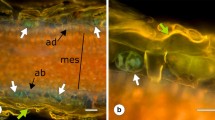Summary
In the crab cuticle the interprismatic septa (IS), which correspond to imprints left in the cuticle by the margins of the epidermal cells, penetrate the twisted structure of the chitin-protein matrix. The ultrastructure and geometric relationship between the fibrous architecture and the pattern of the prisms is described.
The cytochemical characterization of the IS, by pronase treatment and ruthenium red staining, supports the hypothesis that this material corresponds to cell-coat glycoproteins released in the cuticle during secretion of the organic matrix.
Calcification begins after ecdysis in the external laminae of the pigmented layer and along the IS. The presence of cation-binding glycoproteins in the sites where calcification is initiated could induce the nucleation of the mineral phase by concentrating calcium. The extracellular distribution of carbonic anhydrase, which favours carbonate deposition, is observed on ultrathin sections over the IS.
Similar content being viewed by others
References
Anderson RE, Gay CV, Schraer H (1982) Carbonic anhydrase localization by light and electron microscopy: a comparison of methods. J Histochem Cytochem 30:1135–1145
Borman AH, de Jong EW, Huizinga M, Kok DJ, Westbroek P, and Bosch L (1982) The role in CaCO3 crystallization of an acid Ca2+-binding polysaccharide associated with Coccoliths of Emiliania huxleyi. Eur J Biochem 129:179–183
Bouligand Y (1970) Aspects ultrastructuraux de la calcification chez les crabes. VIIe Congrès intern de micr électr Grenoble, vol 3:105–106
Bouligand Y (1972) Twisted fibrous arrangements in biological materials and cholesteric mesophases. Tissue & Cell 4(2):189–217
Drach P (1939) Mue et cycle d'intermue chez les Crustacés Décapodes. Ann Inst Océan (Paris) (N.S.) 19:103–391
Giraud MM (1981) Carbonic anhydrase activity in the integument of the crab Carcinus maenas during the intermolt cycle. Comp Biochem Physiol 69A:381–387
Giraud-Guille MM (1984) Tissue & Cell 16 in press
Giraud-Guille MM, Quintana C (1982) Secondary ion microanalysis of the crab calcified cuticle: Distrubtion of mineral elements and interactions with the cholesteric organic matrix. Biol Cell 44:57–68
Hansson H (1967) Histochemical demonstration of carbonic anhydrase activity. Histochemie 11:112–128
Ito S, Karnovsky MJ (1968) Formaldehyde-Glutaraldehyde fixatives containing trinitro compounds. J Cell Biol 39:168a
Livolant F, Giraud MM, Bouligand Y (1978) A goniometric effect observed in sections of twisted fibrous materials. Biol Cell 31:159–168
Lönnerholm G (1980) Carbonic anhydrase in rat liver and rabit skeletal muscle, further evidence for the specificity of the histochemical cobalt-phosphate method of Hansson. J Histochem Cytochem 28:427–433
Luft JH (1971) Ruthenium red and violet. I. Chemistry, purification, Methods of use for electron microscopy and mechanism of action. II. Fine structural localization in animal tissues. Anat Rec 171:347–368, 369–392
Maren TH (1980) Kinetics, equilibrium and inhibition in the Hansson histochemical procedure for carbonic anhydrase: A validation of the method. Histochem J 12:183–190
Mauchamp B, Schrével J (1977) Observations en microscopie à fluorescence de la cuticule des insects: une méthode faisant appel aux propriétés spécifiques de la WGA vis-à-vis des glycoconjugués de la chitine. CR Acad Sc 285D:1107–1110
Monneron A (1966) Utilisation de la pronase en cytochemie ultrastructurale. J Microsc 5:583–596
Muther TF (1977) On the lack of specificity of the cobalt-bicarbonate method for carbonic anhydrase. J Histochem Cytochem 25:1043–1050
Reynolds ES (1963) The use of lead citrate at high pH as an electron-opaque stain in EM. J Cell Biol 17:208–211
Roer R (1980) Mechanisms of resorption and deposition of calcium in the carpace of the crab Carcinus maenas. J Exp Biol 88:205–218
Rudall KM (1965) Skeletal structure in insects. Biochem Soc Symp 25:83–92
Scanlin TF, Glick MC (1977) Turnover of mammalian surface membranes. In: Jamieson GA, Robinson DM (ed) Mammalian cell membranes. vol. 5, Butterworths London-Boston, pp 1–28
Simkiss K (1964) Phosphate as crystal poisons of calcification. Biol Rev 39:487–505
Simkiss K (1976) Cellular aspects of calcification. In: Watabe W, Wilbur KM (ed) The mechanisms of mineralization in the invertebrates and plants. University of South Carolina press for the Belle W. Baruch Library in marine science, (5) Columbia, South Carolina, pp 1–31
So LL, Goldstein U (1967) Protein carbohydrate interaction. IX. Application of the quantitative hapten inhibition technique to polysaccharide-concanavalin A interaction. Some coments on the forces involved in concanavalin A-polysaccharides interactions. J Immunol 99:158–163
Sugai N, Ito S (1980) Carbonic anhydrase ultrastructural localization in the mouse gastric mucosa and improvements in the technique. J Histochem Cytochem 28:511–525
Travis DF (1963) Structural features of mineralization from tissue to macromolecular levels of organization in the decapod crustacea. Ann NY Acad Sc 109:117–245
Vittur F, Zanetti M, Stagni N, de Bernard B (1979) Further evidence for the participation of glycoproteins to the process of calcification. Perspect Inherit Metab Dis 2:13–30
Vitzou AM (1882) Recherches sur la structure et la formation des téguments chez les Crustacés Décapodes. Arch Zool Exp 10:451–476
Wheeler AP, George JW, and Evans CA (1981) Control of calcium carbonate nucleation and crystal growth by soluble matrix of oyster shell. Science 212:1397–1398
Author information
Authors and Affiliations
Rights and permissions
About this article
Cite this article
Giraud-Guille, M.M. Calcification initiation sites in the crab cuticle: The interprismatic septa. Cell Tissue Res. 236, 413–420 (1984). https://doi.org/10.1007/BF00214245
Accepted:
Issue Date:
DOI: https://doi.org/10.1007/BF00214245




